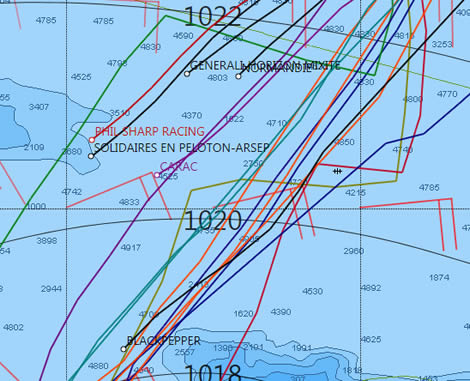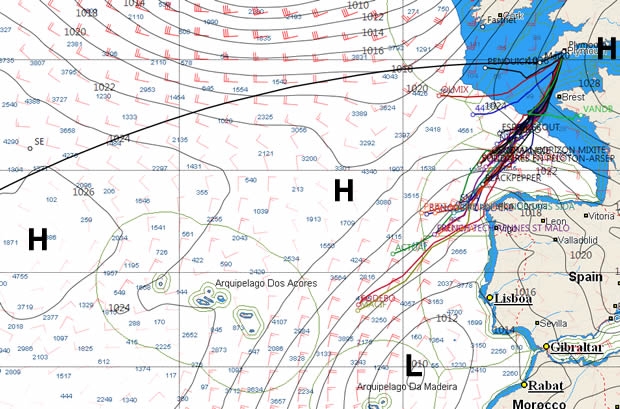Three down
The world is becoming a small place thanks to the Ultime multihulls that are now forging their way across the Atlantic in the Transat bakerly. Having started from Plymouth on Monday afternoon, some 40 hours into the race, race leader Francois Gabart's MACIF, with Thomas Coville on Sodebo in hot pursuit, are already at the latitude of Lisbon/the Azores, some 400 miles due east of the Portugese capital.
The boats are currently making high speed down a band of favourable northeasterlies between a lobe of the Azores high to their north, that is bringing, finally, summery temperatures to the UK, and a shallow depression centred over Madeira, to the southeast of the multihull leaders. Since gybing off Vigo yesterday afternoon both boats have covered around 420 miles in the last 18 hours. Despite being quite different boats albeit both being trimarans of roughly 100ft, just nine miles separate them down the race course, showing how close racing can be in an open class.
This morning Gabart reported: “It is going well – and very quick. There is around 30 knots of wind and big seas which is causing the boat to fly off the waves. Overnight it has been really dark – there were only three stars in the sky. We monitor the tracking to see where Thomas is. There are not many miles in it and when we go at 30 knots, it means 40 minutes is nothing.”
Despite the speed, the course of the majority of the fleet remains the unique thing about this race. They are supposed to be heading for New York, not Guadeloupe! At present the course of the lead Ultimes is the Caribbean. MACIF is currently steering 239°, whereas New York, still some 2500 miles away, is on a course of 292°. The lead Ultimes have diverged by almost 700 miles southeast from the great circle route between Plymouth and New York.
One wonders how well they would survive crashing upwind on a traditional OSTAR course. Perhaps they are so long legged that they will never go upwind but simply sail around any areas where they might have to do this.
The weather for this Transat is certainly unusual with the Azores high remaining fairly static, bang in the middle of the Atlantic, ie southwest of the Azores, the forecast having it in fact edging northwest, towards the southern side of the ice exclusion zone early next week. Anyone wishing for the 'proper OSTAR experience' will be shortchanged as the door closes on the upwind route around the high.
To sail around the south of the Azores means that if the Ultimes want to stay in pressure they will have to take the mother of all southerly routes, down to the latitude of the Canaries, ie around 27-28°N before they can skirt around the south side of the high. New York is at 40°30N. There seems to be little likelihood that the Ultimes will gybe today and head upwind around the north side of the high, which would be the equivalent of boats on the opening leg of the Volvo Ocean Race beating down the west coast of Africa.
While the Ultimes have the speed to carry this out - will the Multi 50s and IMOCA 60s sail a similar route? At present the forecast indicates that if they were to do this, it might favour them with the high forcecast to edge north over the next week, meaning that they should be able to sail a shorter course than the Ultimes. The good news for both is that with this route they will be getting suntans rather than dodging icebergs and fishing boats in the fog and they will also avoid having to sail directly into, at times, three knots of adverse Gulf Stream as they approach the finish. Instead they will be sailing across it.
Elsewhere, in the Multi 50 fleet Lalou Roucayrol on Arkema and Gilles Lamire on FrenchTech Rennes St Malo are making 15-20 knots downwind, neck and neck for the lead after yesterday's leader, Erwan Le Roux's FenêtréA Cardinal, at around 1700 UTC yesterday sustained substantial damage to her port float while sailing downwind in 25-27 knot northeasterlies, some 60 miles off Cape Finisterre.
“I had two reefs in the mainsail at the time and at first it was a big shock. I did not see what happened because I was under the cockpit cover," explained Le Roux. “I had to intervene immediately to avoid a capsize. I went to roll the gennaker and that’s when I realised that about half of the float was missing."
“It is super, super hard for me and also frustrating,” added the triple winner of the Transat Jacques Vabre, who is currently heading upwind on port tack, and is expected to reach port near La Coruña within 24 hours.
Le Roux is not the only class leader to fall by the wayside. Shortly after midnight, Edmond de Rothschild skipper Sébastien Josse, reported damage to his yacht's mainsail.
At the time of Cape Finisterre sailing in 25-30 knots of breeze, the Baron de Rothschild-backed IMOCA 60 broached during a gybe, resulting in irreparable damage to her main sail battens. Josse had turned towards Vigo, some 80nm away.
“Everything happened very quickly, in maybe 10 seconds. I broke the battens in the mainsail, which hold the top of the sail, in a violent gybe. Despite all precautions, it is unfortunate but these things can happen," explained Josse.
“The damage is not spectacular, but it is impossible to continue the race. It is really disappointing – I was in the game, in contact with Armel and Vincent. The boat was very well prepared. That’s all the more frustrating as I think the hardest part of this first race was behind us.”
This leaves a two horse race for the lead of the IMOCA 60s with Vincent Riou on the conventionally foiled PRB edging ahead of Armel le Cleac'h on Banque Populaire and Jean-Pierre Dick on St Michel Virbac, both new generation foils. This indicates that a conventionally foiled boat still has the edge in running conditions. Interestingly the IMOCA 60s are sailing a slightly hotter course across the northeasterlies than the Ultimes and while they may still gybe south, it does look like they may be manning up to take on the front and 30 knot headwinds accompanying them which are due tomorrow night (if they stay on their present course).
With Maxime Sorel's V&B suffering a collision with a ship yesterday, three boats have to date had to retire from the Transat bakerly, a relatively low attrition rate - one wonders how high it might have been if the boats had taken the 'northern' route.
Further north and making their way through the Bay of Biscay, former Mini Transat winner Armel Tripon on Blackpepper has stolen a march on the Class40 fleet. The former Mini Transat winner wisely chosen an easterly route across the Bay of Biscay and staying in better pressure and is now, despite what the official DTF figure indicate, some 30 mile ahead of the competition. Solidaires en Peloton-ARSEP, skippered by Thibaut Vauchel is narrowly ahead of Britain's Phil Sharp on Imerys who is technically leading the Class40 in terms of DTF seems to have missed the part of the sailing instructions where it prohibits sailing through TSSes. FFS.
Images courtesy of Expedition and PredictWind














Latest Comments
Add a comment - Members log in